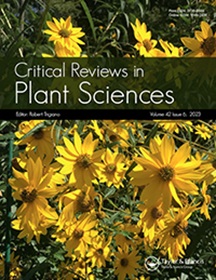湿地植物入侵机制与影响的研究进展:20年回顾分析及未来20年的重点
IF 4.9
2区 生物学
Q1 PLANT SCIENCES
引用次数: 0
摘要
摘要入侵植物是许多湿地系统中普遍存在的特征,其造成的影响在经济和生态方面都是极其昂贵的。大约20年前,这些影响和入侵背后的许多机制在两篇关于该主题的经典综述论文中得到了体现。这两项贡献指导了过去二十年的大量研究工作。在这里,我们使用最先进的综述,概述了过去20年的研究进展 确定未来20年的研究重点 年。我们围绕早期综述中出现的关键主题构建了这些见解,并强调了湿地入侵与高地植物入侵的区别。我们首先强调了湿地植物入侵影响的研究进展和优先事项。然后,我们对七种广泛的机制进行了同样的研究,这些机制被认为可以提高湿地入侵的成功率。入侵植物显然会影响湿地的各级生态组织和景观尺度,但关于影响程度变化的驱动因素,仍缺乏可概括的结论。入侵成功的关键机制之一反映了站点级资源可用性的变化,尽管我们知道资源的增加往往会导致更多的入侵机会,但对离散资源脉冲的作用以及资源可用性与繁殖体压力变化相互作用的方式知之甚少。其次,尽管从天敌那里释放是入侵成功的一个长期潜在驱动因素,但最近的见解支持了这样的猜测,即这些影响可能在湿地中特别明显。第三,尽管大多数入侵湿地植物被认为是很好的竞争对手,但它们同时作为应激耐受者的作用引发了一个问题,即对生活史权衡的期望是否比这些理论所围绕的高地物种更不适用于湿地入侵者。第四,尽管人们敏锐地认识到湿地植物入侵者是机会主义的,会对干扰做出快速反应,但种子和幼苗性状的核心重要性尚未得到充分研究,无法整合个体发生阶段的生命史理论。第五,尽管许多入侵湿地植物既有性繁殖,也无性繁殖,但这种混合策略在多大程度上有助于它们作为入侵者取得成功,尚未得到严格评估。第六,尽管观察到湿地入侵者通常表现出高度的表型变异性,但湿地入侵者的成功与高种群遗传多样性或高表型可塑性之间的因果关系尚未明确确立。最后,尽管人们长期关注种间杂交是否有助于湿地入侵者的成功,但最近的研究强调,导致多倍体和基因组大小变化的进化过程是需要进一步研究的替代方案。最后,我们提出了优先考虑湿地植物入侵研究的愿景,从这篇综述中提出了见解,旨在启发未来对湿地与高地入侵者的相对影响以及表型可塑性、种群遗传多样性、敌人释放的相对重要性等关键不确定性的研究,以及影响湿地与高地系统中入侵植物成功的人为干扰。本文章由计算机程序翻译,如有差异,请以英文原文为准。
Progress on Mechanisms and Impacts of Wetland Plant Invasions: A Twenty-Year Retrospective Analysis and Priorities for the Next Twenty
Abstract Invasive plants are ubiquitous features of many wetland systems, resulting in impacts that are extremely costly in both economic and ecological terms. Approximately twenty years ago, these impacts and many of the mechanisms underlying invasion were crystallized in a pair of now-classic review papers on the topic. These two contributions have guided substantial research efforts over the past two decades. Here, using a state-of-the-art review, we present an overview of research progress from the past 20 years and identify research priorities for the next 20 years. We structure these insights around key themes that emerge from those earlier reviews and emphasize ways wetland invasions might be distinguished from plant invasions in uplands. We first highlight research progress and priorities around the impacts of wetland plant invasions. We then do the same for seven broad mechanisms that have been postulated to enhance invasion success in wetlands. Invasive plants clearly impact wetlands across all levels of ecological organization and up to landscape scales, but generalizable conclusions are still lacking concerning what drives variation in impact magnitudes. One of the key mechanisms underlying invasion success reflects site-level variation in resource availability and, although we know that increased resources often lead to more opportunities for invasion, the role of discrete resource pulses and the way resource availability may interact with propagule pressure variability are poorly understood. Second, although release from natural enemies is a long-held potential driver of invasion success, recent insights support speculation that these effects may be especially pronounced in wetlands. Third, although most invasive wetland plants are considered good competitors, their simultaneous role as stress tolerators raises questions about whether expectations regarding life history tradeoffs may be less applicable for wetland invaders than for the upland species around which these theories were designed. Fourth, despite a keen understanding that wetland plant invaders are opportunistic, establishing quickly in response to disturbance, the central importance of seed and seedling traits has not been adequately studied to integrate life history theory across ontogenetic stages. Fifth, although many invasive wetland plants reproduce both sexually and asexually, the extent to which this mixed strategy contributes to their success as invaders has not been rigorously assessed. Sixth, despite observations that wetland invaders often exhibit a high degree of phenotypic variability, causal connections between the success of wetland invaders and either high population genetic diversity or high phenotypic plasticity have not been clearly established. Lastly, despite long-standing interests in whether interspecific hybridization contributes to wetland invader success, recent studies have highlighted evolutionary processes leading to variation in polyploidy and genome size as alternatives requiring additional study. We conclude with a vision for prioritizing wetland plant invasions research, presenting insights from this review aimed at inspiring future studies on remaining key uncertainties regarding the relative impacts of wetland vs. upland invaders and the relative importance of phenotypic plasticity, population genetic diversity, enemy release, and anthropogenic disturbances for influencing the success of invasive plants in wetland vs. upland systems.
求助全文
通过发布文献求助,成功后即可免费获取论文全文。
去求助
来源期刊
CiteScore
12.90
自引率
1.40%
发文量
15
审稿时长
>12 weeks
期刊介绍:
Critical Reviews in Plant Sciences focuses on presenting in-depth and up-to-date reviews of timely and/or cutting-edge subjects in the broad discipline of plant science, ranging from molecular biology/biochemistry through the areas of cell biology, plant pathology and physiology, genetics, classical botany, and ecology, to practical agricultural applications. Articles in the journal provide an up-to-date literature base for researchers and students, pointing the way towards future research needs. The journal is also a significant source of credible, objective information to aid decision makers at all levels.

 求助内容:
求助内容: 应助结果提醒方式:
应助结果提醒方式:


